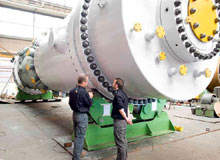
For an energy- and chemical-hungry economy such as China, the problem of continuing supplies of liquid fuels and chemical feedstocks is moot. One of the world’s largely untapped hydrocarbon reserves – and one that China has in abundance, with proven reserves of over a trillion tons (Ministry of Land and Resources figure) – is coal.
The interest in coal gasification technology, which was first developed more than 100 years ago, has now increased in several coal-rich countries, including China. The Chinese Government is pursuing coal to liquids (CTL) projects as part of a national energy policy costing more than $10bn.
The two companies driving the technology in China are Shenhua Group Corporation Ltd and Ningxia Coal Industry Co Ltd (Ningmei). Shenhua alone has coal reserves of more than 220bn tons and a production capacity of 60m tons per year.
CTL technology produces an enormous amount of CO2 and the contention has been that the coal should be used to produce electricity, which will allow higher efficiency and the use of clean coal technology, or else the CTL must be developed in conjunction with carbon sequestration projects. In addition CTL is a water-hungry process and this natural resource may also become crucial.
First CTL commercial plant in China
The Shenhua Group Corporation, which is one of the world’s largest coal companies, began to construct the world’s first commercial direct coal liquefaction plant, located in Inner Mongolia (80 miles south of Baotau at Majata) in 2003, at a cost of $3.2bn (this is an area with huge coal fields). China Shenhua Coal Liquefaction Co Ltd (CSCLCL) is the operating company for the plant.
The first phase of the facility opened in July 2009 and employ US-developed technology from Headwaters Inc and Hydrocarbon Technologies Inc (HTI) in conjunction with West Virginia University and the US Department of Energy. The facility will have three reactor trains when the second phase is completed in 2010 and will be able to produce 6m tons of oil products per year.
The first train, which entered trial production in July 2009, converts 3.45m tons of coal into a million tons of oil products (22,000bbl per day of liquid fuel). Beijing plans to have CTL capacity approaching 50m tons by 2020 and Inner Mongolia plans to turn half of its coal output into liquid fuel or chemicals by 2010, which will be around 135m tons – or about 40% of Australia’s annual coal output.
Figures have suggested that it costs $67-82 a barrel to produce CTL fuel (figures from SASOL). But with prices of Brent crude approaching $150 per barrel at times in 2008, these figures begin to make economic sense.
Coal to chemicals
In May 2008 Siemens Energy supplied the first two of an order of five coal gasifiers to Shenhua Ningxia Coal Industry Group Co Ltd (SNCG). Each of these has a thermal capacity of 500 megawatts and are used for the Ningxia coal-to-polypropylene (NCPP) plant in Ningxia Province in north-west China.
The new plant, with its five gasifiers, has an hourly production capacity of about 540,000 cubic metres of syngas, which is converted in a series of downstream processes to polypropylene plastic. The Siemens coal gasifiers are 18m long, with an inside diameter of 3m and a weight of 220t.
The initial trial of this facility for 300 hours, was successfully completed in December 2008. Completion of the second trial in July 2009 saw the launch of the facility.
They are capable of gasifying up to 2,000t of coal daily. The gasification process converts hard coal, lignite, biomass, petcoke and refinery residues to syngas, and environmental pollutants such as sulphur and carbon dioxide are removed and sequestrated or stored.
The syngas can then be used for eco-friendly power generation in integrated gasification combined cycle (IGCC) plants or as chemical industry feedstock (fuels or polymers). The technology for the Siemens gasifiers was obtained from the Swiss company Sustec Holding AG in 2006, along with a 50% share in the Chinese coal gasifying project.

